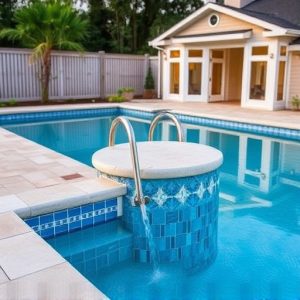Secure Splashes: Essential Inground Pool Alarm Installation and Safety Tips
Swimming pool alarms are essential safety devices for inground pools, providing an early warning sy…….
Swimming pool alarms are essential safety devices for inground pools, providing an early warning system against unauthorized access or water disturbances. These alarms comply with local safety regulations and play a critical role in protecting swimmers by alerting homeowners and lifeguards in real-time. Their importance is underscored by the higher drowning risks associated with inground pools due to their depth and enclosed nature. The best alarms offer both motion-activated and wave-detecting capabilities, adapting to the specific needs of each pool. Regular maintenance, strategic placement, and consistent testing are vital for maintaining alarm reliability and effectiveness in emergencies. Pool owners should stay informed about different types of alarms, including those that monitor water chemistry, to ensure a secure and safe environment for all users. Adhering to these safety measures, along with physical barriers and clear signage, creates a robust safety strategy for inground pools. Compliance with local regulations regarding swimming pool alarms is not just about meeting legal standards; it's a critical step in preventing accidents and safeguarding lives.
When the warm sun beckons and families flock to their backyards for a refreshing dip, ensuring the safety of an inground pool becomes paramount. This article delves into the critical aspects of inground pool safety, highlighting the necessity for vigilance and proactive measures. From understanding the importance of safety protocols to navigating legal requirements, we explore how swimming pool alarms for inground pools play a pivotal role in safeguarding lives. We also provide a detailed guide on installing these alarms and outline best practices for maintaining a secure environment around your inground pool. Compliance with local regulations is also discussed to guarantee that your pool adheres to the highest safety standards. Dive into this comprehensive guide to transform your inground pool into a safe haven for enjoyment and peace of mind.
Understanding the Importance of Inground Pool Safety
Swimming pool alarms play a pivotal role in enhancing the safety measures for inground pools. These alarms, which can be designed to detect unauthorized access or water surface disturbances, serve as an early warning system that can alert homeowners and lifeguards to potential dangers in real-time. By installing such alarms, pool owners not only comply with local safety regulations but also demonstrate a commitment to the well-being of swimmers. These devices are particularly important due to the depth and enclosed nature of inground pools, which can pose higher risks than above-ground counterparts. The importance of these systems is underscored by the fact that drowning incidents often occur without a sound, making silent but effective monitoring a critical aspect of safety protocols. Pool alarms are an integral part of a comprehensive safety strategy that includes proper barrier enforcement, clear signage, and regular maintenance to ensure the pool environment remains safe for everyone.
Incorporating swimming pool alarms into the safety infrastructure of inground pools is a proactive measure that can prevent tragic accidents. These devices, when strategically placed around the pool perimeter, can act as a secondary line of defense alongside physical barriers like fences and gates. The choice between motion-activated and wave-detecting alarms should be informed by the specific layout and usage patterns of the pool, allowing for tailored protection suited to each inground pool’s unique requirements. It is imperative for pool owners to educate themselves on the types of alarms available and to understand the importance of regular testing and maintenance to ensure these systems function optimally when needed most. By prioritizing inground pool safety through the use of advanced alarm systems, pool owners can significantly reduce the risk of accidents and create a safer swimming environment for all.
Installing Swimming Pool Alarms: A Comprehensive Guide for Inground Pools
When prioritizing safety measures for your inground pool, installing a reliable swimming pool alarm system is a critical step in ensuring the well-being of all users. These alarms are designed to automatically detect and alert you to unauthorized access or potential dangers within the water, offering an additional layer of protection beyond physical barriers like fences and gates. To select the most suitable alarm for your inground pool, consider models that offer both surface motion and water chemistry monitoring capabilities. Surface motion detectors can sense when someone enters the pool area, while water chemistry sensors alert you to significant changes in chemical levels that could pose a hazard.
Upon installation, ensure that the swimming pool alarms for inground pools are positioned strategically around your pool perimeter. This typically involves placing one alarm at the pool’s entrance and others at corners or along the length of the pool, depending on the system’s design and coverage specifications. Proper placement is essential to guarantee that the alarm can effectively detect any unauthorized movements or water quality shifts. Additionally, regularly test your swimming pool alarms for inground pools to ensure they are functioning correctly and replace the batteries as needed. This vigilance contributes significantly to maintaining a safe environment for swimmers of all ages and skill levels.
Best Practices for Maintaining a Safe Inground Pool Environment
Regular upkeep and strict adherence to safety protocols are paramount in maintaining a secure inground pool environment. One of the most effective measures is installing swimming pool alarms for inground pools. These devices can detect unexpected water movements or entry, alerting homeowners or lifeguards immediately to potential dangers such as unauthorized access or accidents. It’s crucial to select alarms that comply with local safety regulations and are sensitive enough to distinguish between legitimate swimmers and false triggers.
Additionally, pool owners should ensure that all safety equipment, including life rings, reach poles, and first aid kits, are readily accessible and in good working order. Clear signage indicating pool depths, emergency numbers, and CPR instructions should be prominently displayed around the pool area. Regular inspections of the pool’s structure, filtration system, and electrical components are also essential to prevent accidents caused by structural failure or equipment malfunction. Regularly cleaning the pool, maintaining appropriate chemical balances, and conducting regular safety drills further enhance the safety of inground pools. By combining these best practices with the use of swimming pool alarms for inground pools, pool owners can create a safer environment for all users to enjoy.
Legal Requirements and Compliance for Inground Pool Safety in Your Area
When installing an inground pool, adherence to local regulations is paramount to ensure safety and compliance. Legal requirements for inground pool safety can vary significantly by region, so it’s essential to consult with local building authorities or a certified pool installer who understands the nuances of your area’s codes. These regulations often mandate specific safety features, such as swimming pool alarms for inground pools, which are designed to alert homeowners and nearby individuals if a potential hazard, like an unauthorized child or pet entering the water, is detected. Such alarms can be both surface motion and underwater, with the latter being particularly effective in detecting accidental or intentional submersions.
In addition to physical barriers like fencing and protective covers, automated safety systems play a crucial role in preventing drowning incidents. Swimming pool alarms are one such system, and their installation is sometimes stipulated by law as part of a comprehensive safety plan. These devices can be integrated with other home security systems for a more robust safety solution. It’s important to ensure that the chosen alarm system complies with the local standards and ordinances, which may dictate specific models or technologies deemed most effective for your community. Regular maintenance and testing of these alarms are also typically required by law to guarantee their functionality when needed most. Staying informed about and adhering to these legal requirements is not just a matter of compliance; it’s a critical step in safeguarding the lives of swimmers and those who may accidentally gain access to the pool area.


